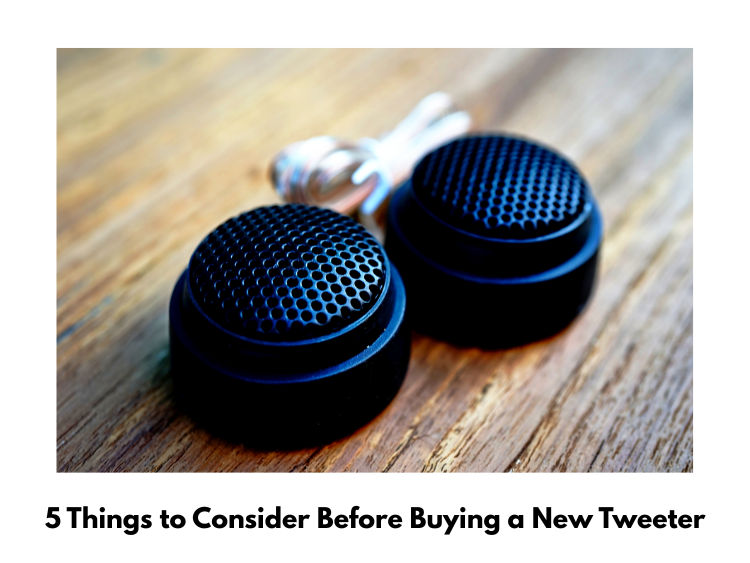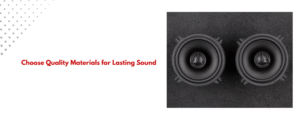Tweeters are essential for producing clear, detailed sound from your sound system. Your music comes to life with high-frequency sounds, like drums, voices, and the subtleties of instruments. These small drives are what make them happen. Picking the correct tweeter is very important, whether you’re improving your home theater or making small changes to the sound in your car. Dome tweeters are better than others, though. Before you buy, here are five important things to think about to make sure you get the right sound for your needs.
Find Out About the Different Kinds of Tweeters
What kind of tweeter you want is one of the first things you should think about. There are different styles available, and each one sounds different. Most speakers use dome tweeters, which can be made of silk, metal, or titanium, among other materials. Smooth, warm highs come from soft dome tweeters made of silk or textile mixes. These are perfect for hearing inside.
Highs that are brighter and more defined come from metal dome tweeters, like those made of aluminum or titanium. These are better for high-output systems. You can also choose horn tweeters and ribbon tweeters, which have even more specific sound qualities. Horn tweeters are louder and more directed, while ribbon tweeters are known for having a very accurate and smooth response. A very important first step is to figure out what kind of tweeter works best for your hearing surroundings and sound tastes.
If you’re also planning to upgrade other parts of your system, check out this helpful guide on the Top 5 Car Replacement Speakers for Superior Sound Quality in 2025 to pair your tweeters with the right components.
Examine the Frequency Response Range.
For tweeters in particular, frequency response is a crucial success measure. High frequencies, usually from about 2,000 Hz to 20,000 Hz or even higher, are what tweeters are made to handle. If your tweeter has a wide and accurate frequency response, you won’t miss out on small musical details like high-pitched screams or string harmonics.
There are times when bigger numbers are not better, though. What matters more is that the tweeter handles the frequency range it claims cleanly and accurately. Check out both ends of the range and see how easily the tweeter goes from mid-range to high-range sounds. This is especially important if you’re going to be connecting it to other speakers.
Consider Power Handling and Sensitivity
It is important to make sure that the tweeter’s power handling abilities match those of the amplifier for best long-term performance and stability. The tweeter might not give you the clarity and volume you want if it is not powerful enough. If it’s pushed too far, on the other hand, it can get hurt. Do not just look at the peak power rating; pay close attention to the RMS power rating.
This will give you a more accurate picture of what the tweeter can handle. Another important factor is sensitivity, which is measured in decibels (dB) and tells you how well the tweeter turns power into sound. The tweeter can make more sound with less power if it has a better sensitivity grade. This is especially helpful in car audio systems where power is limited.
Think About the Material and Build Quality
How well the tweeter is made and what it’s made of will have a big effect on both how long it lasts and how it sounds. Since some materials are different, each one gives you a different sound experience. The dome is important, but the type of magnet and the housing are also important.
People often choose high-quality neodymium magnets because they are strong and small. The case or fastening tools should also be strong enough to keep the sound from being distorted by movements. For setups in cars or outside, materials that don’t get wet may be needed. By buying a tweeter with strong parts, you can be sure that it will work well and last a long time.
Ensure Compatibility with Your Existing System
If it doesn’t work well with your other speakers, even the best tweeter won’t sound great. Check them to make sure that the resistance values match your amplifier or crossover system. The values for most tweeters are either 4 or 8 ohms. Also, make sure that the crossover network is blocking out low frequencies properly so that the tweeter only gets the high-frequency sounds it was made to handle. When you set the crossing incorrectly, it can cause distortion or even damage that lasts forever. Physical compatibility is also important. For example, the tweeter should fit in the case you already have or the dashboard of your car if you’re putting it there.
Conclusion
Just ignoring the most expensive or most powerful tweeter isn’t enough. It’s important to know how the tweeter will work with your sound system, what kind of sound you want, and how long it will last. If you understand the tweeter type, frequency range, power handling, build quality, and whether it fits your system, you can make a smart choice. The right tweeter will give you clearer sound and a better overall listening experience.




